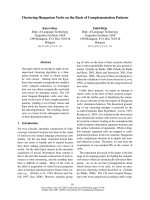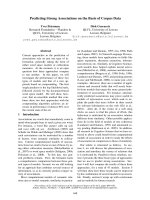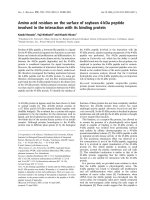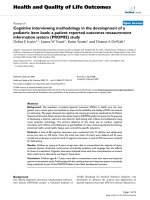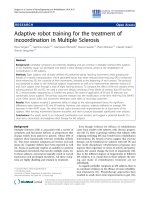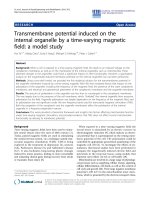Báo cáo hóa học: " Growth Interruption Effect on the Fabrication of GaAs Concentric Multiple Rings by Droplet Epitaxy" pptx
Bạn đang xem bản rút gọn của tài liệu. Xem và tải ngay bản đầy đủ của tài liệu tại đây (225.45 KB, 4 trang )
SPECIAL ISSUE ARTICLE
Growth Interruption Effect on the Fabrication of GaAs
Concentric Multiple Rings by Droplet Epitaxy
C. Somaschini
•
S. Bietti
•
A. Fedorov
•
N. Koguchi
•
S. Sanguinetti
Received: 22 July 2010 / Accepted: 9 August 2010 / Published online: 21 August 2010
Ó The Author(s) 2010. This article is published with open access at Springerlink.com
Abstract We present the molecular beam epitaxy fabri-
cation and optical properties of complex GaAs nanostruc-
tures by droplet epitaxy: concentric triple quantum rings. A
significant difference was found between the volumes of
the original droplets and the final GaAs structures. By
means of atomic force microscopy and photoluminescence
spectroscopy, we found that a thin GaAs quantum well-like
layer is developed all over the substrate during the growth
interruption times, caused by the migration of Ga in a low
As background.
Keywords Molecular beam epitaxy Á Droplet epitaxy Á
GaAs nanostructures Á Photoluminescence
Introduction
The fabrication of semiconductor quantum nanostructures
based on self-assembly has deeply attracted the research
community because of the interest in fundamental physics
and the potential applications of these systems as building
blocks for novel devices and quantum information tech-
nologies [1–3]. In particular, quantum rings, a special class
of semiconductor nanostructures, have been investigated
since they manifest a quantum-interference phenomenon,
known as the Aharonov–Bohm (AB) effect [4], and have
also been applied for the fabrication of optoelectronic
devices [5–7]. Therefore, the ability in the production of
quantum ring systems has a great relevance in the nano-
technology field. During the last 15 years, molecular beam
epitaxy (MBE) has been successfully employed for the
fabrication of semiconductor nanoscopic rings, without the
use of any lithographic step [8–11]. Based on droplet epi-
taxy (DE) [12, 13], we recently demonstrated the fabrica-
tion and discussed the growth of GaAs concentric multiple
quantum rings [14]. The innovation in our growth protocol,
compared with the standard DE, resides in the multiple
steps used for the droplets crystallization. Normally the
crystallization of nanometer-sized Ga droplets, automati-
cally formed at the substrate surface after irradiation of Ga,
has been achieved by supplying an As flux until the com-
plete consumption of Ga atoms. On the contrary, we
introduced many pulsed arsenization steps at different
substrate temperatures, opening the possibility for the
fabrication of more complex GaAs nanostructures. The
partial crystallization of the available Ga inside the droplets
allows changes in the subsequent As supply condition
(arsenic BEP and substrate temperatures), adding an
important degree of freedom in the fabrication technique.
Here, we will discuss the formation of concentric triple
quantum rings (CTQRs), describing the morphological
features by means of atomic force microscopy (AFM)
analysis, and we will show the optical properties of the
system, investigated by photoluminescence (PL) spectros-
copy. Interestingly, we found that the volume of the final
GaAs nanostructure is much lower than the expected value,
estimated from the initial amount of supplied Ga. This
discrepancy is justified in terms of Ga atoms diffusion from
the droplets to high distance onto the substrate surface
during the growth interruption steps of the procedure. This
explanation is supported by the presence of an additional
peak in the PL spectra consistent with the emission of a
C. Somaschini Á S. Bietti Á N. Koguchi Á S. Sanguinetti (&)
L-NESS and Dipartimento di Scienza dei Materiali, Universita’
di Milano Bicocca, Via Cozzi 53, 20125 Milan, Italy
e-mail:
A. Fedorov
CNISM, L-NESS and Dipartimento di Fisica, Politecnico di
Milano, Via Anzani 42, 22100 Como, Italy
123
Nanoscale Res Lett (2010) 5:1897–1900
DOI 10.1007/s11671-010-9752-5
quantum well-like thin layer of GaAs formed all over the
substrate.
Experimental Details
The growth experiments were performed in a conventional
GEN II MBE system using epi-ready GaAs (001) sub-
strates. After the growth of a 500-nm-thick GaAs buffer
layer and of a 200-nm-thick Al
0.3
Ga
0.7
As barrier layer at
580°C, the substrate temperature was decreased to 350°C
and the As valve closed until the background pressure was
below 1 9 10
-9
Torr. At the same temperature, a Ga
molecular beam equivalent to the formation of 10 ML of
GaAs in the presence of As was supplied to the substrate
surface, for the droplets formation. After that, the substrate
temperature was decreased to 250°C and an As BEP of
8 9 10
-7
Torr was supplied for 20 s for the partial crys-
tallization of the original droplets into GaAs. Finally, the
substrate temperature was increased to 300°C and the
sample surface was irradiated by the same As BEP
(8 9 10
-7
Torr) for 20 min, to ensure the complete reac-
tion of metallic Ga with As. It is worth mentioning that a
growth interruption time of around 1 h was used to reach
the thermal stability of the sample after each change of the
substrate temperature. After the growth, the samples were
taken out of the chamber for the morphological analysis by
AFM and optical investigation by PL. Three samples were
prepared: Sample A by stopping the growth just after the
Ga supply; Sample B after completely performing the
described procedure; and Sample C by burying the GaAs
nanostructure in Al
0.3
Ga
0.7
As and annealing at 650°CinAs
atmosphere for the optical measurements. Photolumines-
cence spectra of Sample C were measured at T = 15 K
using a green laser (k
exc
= 532 nm) as excitation source
with a power density P
exc
= 10 W/cm
2
and recorded by a
Peltier-cooled CCD camera.
Results and Discussion
In Fig. 1 a and b, we show the AFM images of Sample A,
where the growth was stopped just after the deposition of
Ga and Sample B, where the entire procedure was per-
formed. The Ga supply clearly resulted in the formation of
nanometer-sized, nearly hemispherical Ga droplets. Their
average diameter and height were around 80 and 35 nm,
respectively, while the density was estimated to be around
8 9 10
8
cm
-2
. At the end of the procedure, clear CTQRs
structures with good rotational symmetry appeared, with
inner, middle and outer ring diameters of around 80, 140
and 210 nm, respectively, while heights were around 7 nm
for the inner rings, 4 nm for middle rings and 3 nm for the
outer rings. These structures showed an elongation of
around 11% along the [0–11] direction, which might be due
to the anisotropic diffusion of Ga on GaAs (001) surface
[15]. It is worth noticing that the inner rings showed nearly
the same diameter to that of the original Ga droplet and that
the density of the final GaAs structures was equal to that of
the original droplets, confirming that all Ga droplets
transformed into GaAs triple rings at the end of the pro-
cedure. As already discussed in Ref. [14], the formation of
the inner rings comes from the crystallization of the
droplets edge, thus explaining the identity between droplets
and inner rings diameters. On the contrary, middle and
outer rings appear caused by the subsequent As supplies, as
a result of the interplay between As adsorption and Ga
migration from the droplets. Fig. 1 c shows the cross-sec-
tional height profile for Sample A (black line) and B (red
line) obtained from the AFM images. It is important to
point out that there is a significant difference between the
number of Ga atoms initially supplied, corresponding to the
equivalent amount of 10 MLs, and the number of Ga
atoms, evaluated to be equivalent to around 3–4 MLs,
inside the final structure. This difference suggests that only
a fraction of the initially supplied Ga atoms effectively
concur to the formation of the 3D nanostructures, while the
other part, estimated to be around 6–7 MLs, might be
consumed in another process. The reason for this discrep-
ancy might be found considering our experimental proce-
dure for the formation of CTQRs. As mentioned before, the
three main steps of the growth are performed at different
temperatures: 350°C for the droplets formation, 250°C for
Fig. 1 AFM 2 9 2 micron images of Sample A (a) and B (b). Insets
show a 3D-magnified picture of a single structure. Cross sectional
height profiles of a single Ga droplet and concentric triple quantum
ring (c)
1898 Nanoscale Res Lett (2010) 5:1897–1900
123
the first As supply and 300°C for the second As supply. To
establish the thermal equilibrium of the substrate, we
observed 1 h growth interruption times after each change
of the substrate temperature. During these waiting times, a
portion of the Ga atoms stored in the droplets might be
consumed to form a 2D GaAs thin layer all over the sub-
strate. We believe this phenomenon to be caused by a slow
2D crystallization of Ga atoms diffusing from the droplets,
even in the absence of an intentional As supply. Indeed, an
As background pressure of around 1 9 10
-9
Torr is pres-
ent during the whole procedure, thus providing the unin-
tentional As pressure needed for the partial crystallization
of Ga atoms. As we recently found in similar systems, a
slow GaAs crystallization all over the substrate might take
place in case of very low As supply to the Ga droplets [16].
In these conditions of very low As flux, the surface
mobility of Ga atoms is so large that an uniform layer of
GaAs might be formed all over the substrate surface. In a
capped sample, embedded in an Al
0.3
Ga
0.7
As barrier, this
layer can act as a quantum well, confining carriers and
eventually being optically active. In order to check the
optical quality of CTQRs and to confirm the presence of a
thin quantum well-like GaAs layer all over the substrate
coming from the unintentional crystallization of a certain
amount of Ga atoms during the procedure, we performed
PL investigations. The same structure of Sample B was
therefore grown on another sample (Sample C) and
embedded in an Al
0.3
Ga
0.7
As barrier layer. Figure 2 shows
the PL spectra of Sample C excited at 15 K by a green laser
(k
exc
= 532 nm) with a power density P
exc
= 10 W/cm
2
and recorded by a Peltier-cooled CCD camera. In the
region where the emission from quantum-confined GaAs
structures is expected, two peaks, respectively named Peak
1 at 1.55 eV and Peak 2 at 1.76 eV, appeared. A calcula-
tion on the electronic structure for the CTQRs was per-
formed in the framework of the effective mass
approximation [17–20], allowing us to attribute Peak 1 to
the emission of the localized states within the CTQRs. On
the other hand, on the basis of the same theoretical pre-
dictions, Peak 2 can be safely assigned to a 2D GaAs
quantum well (QW), which appeared all over the substrate
during the procedure. As already discussed, only a fraction
of the total supplied Ga is effectively crystallized to form
the Triple Rings, while the remaining 6–7 MLs of Ga
atoms concur to the formation of a 2D layer of GaAs, as
described above. Within the effective mass approximation,
a 6–7 MLs-thick GaAs QW is expected to emit at 1.76 eV,
in excellent agreement with the observed Peak 2 feature.
We believe that the presence of this 2D layer might be a
general feature in the samples grown with our multiple
steps DE, by observing growth interruption times.
Conclusion
We presented the growth and the optical properties of
GaAs CTQRs fabricated by DE. At the end of our multistep
procedure, Ga droplets are transformed into these complex
nanostructures. We found a significant difference in the
volume of the final structure compared to the initially
supplied amount of Ga. We explain this discrepancy in
terms of Ga diffusion all over the substrate during the
growth interruption steps of the experiments, caused by the
residual As partial pressure in the chamber. This picture is
strongly supported by the presence of a high-energy peak
in the PL, which is consistent with the presence of a thin
GaAs quantum well on the substrate.
Acknowledgments This work was partially supported by the
CARIPLO Foundation (prj. QUADIS2–no. 2008-3186).
Open Access This article is distributed under the terms of the
Creative Commons Attribution Noncommercial License which per-
mits any noncommercial use, distribution, and reproduction in any
medium, provided the original author(s) and source are credited.
References
1. P. Michler, A. Kiraz, C. Becher, W.V. Schoenfeld, P.M. Petroff,
L. Zhang, E. Hu, A. Imamoglu, Science 290, 2282 (2000)
2. X. Li, Y. Wu, D. Steel, D. Gammon, T.H. Stievater, D.S. Katzer,
D. Park, C. Piermarocchi, L.J. Sham, Science 301, 809 (2003)
3. P. Solinas, P. Zanardi, N. Zanghi, F. Rossi, Phys. Rev. B 67,
121307 (2003)
4. Y. Aharonov, D. Bohm, Phys. Rev. 115, 485 (1959)
5. T. Mano, T. Kuroda, M. Yamagiwa, G. Kido, K. Sakoda, N.
Koguchi, Appl. Phys. Lett. 89, 183102 (2006)
6. J. Wu, Z. Li, D. Shao, M.O. Manasreh, V.P. Kunets, Z.M. Wang,
G.J. Salamo, B.D. Weaver, Appl. Phys. Lett. 94, 171102 (2009)
Fig. 2 Pholuminescence spectra of CTQRs recorded at 15 K. GaAs
and Al
0.3
Ga
0.7
As peaks appeared at 1.52 and 1.90 eV, respectively.
Between them additional two features appeared, at 1.55 eV (Peak 1)
and at 1.76 eV (Peak 2)
Nanoscale Res Lett (2010) 5:1897–1900 1899
123
7. J. Wu, D. Shao, Z. Li, M.O. Manasreh, V. Kunets, Z. Wang, G.
Salamo, Appl. Phys. Lett. 95, 071908 (2009)
8. J.M. Garcia, G. Medeiros-Ribeiro, K. Schmidt, T. Ngo, J. Feng,
A. Lorke, J. Kotthaus, P. Petroff, Appl. Phys. Lett. 71, 2014
(1997)
9. D. Granados, J.M. Garcia, Appl. Phys. Lett. 82, 2401 (2003)
10. K. Watanabe, N. Koguchi, Y. Gotoh, Jpn. J. Appl. Phys. 39, L79
(2000)
11. T. Mano, N. Koguchi, J. Cryst. Growth 278, 108 (2005)
12. N. Koguchi, S. Takahashi, T. Chikyow, J. Cryst. Growth 111, 688
(1991)
13. N. Koguchi, K. Ishige, Jpn. J. Appl. Phys. 32, 2052 (1993)
14. C. Somaschini, S. Bietti, N. Koguchi, S. Sanguinetti, Nano. Lett.
9, 3419 (2009)
15. K. Ohta, T. Kojima, T. Nakagawa, J. Cryst. Growth 95, 71 (1989)
16. C. Somaschini, S. Bietti, S. Sanguinetti, N. Koguchi, A. Fedorov,
Nanotechnology 21, 125601 (2010)
17. J.Y. Marzin, G. Bastard, Solid.State Commun. 92, 437 (1994)
18. L. Pavesi, M. Guzzi, J. Appl. Phys. 75, 4779 (1994)
19. M. Califano, P. Harrison, Phys. Rev. B 61, 10959 (2000)
20. S. Sanguinetti, K. Watanabe, T. Kuroda, F. Minami, Y. Gotoh, N.
Koguchi, J. Cryst. Growth 242, 321 (2002)
1900 Nanoscale Res Lett (2010) 5:1897–1900
123
